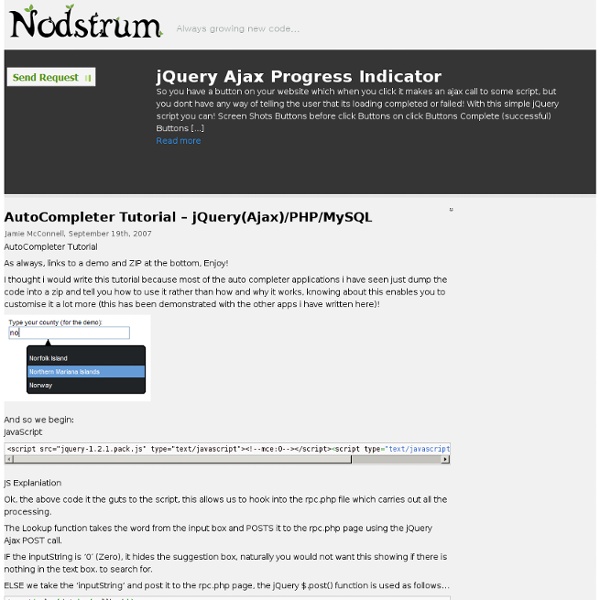AutoCompleter Tutorial - jQuery(Ajax)/PHP/MySQL - Nodstrum

Ajax example - staff directory search with PHP & C# ASP.Net
Ajax in a nutshell is a set of technologies which allow for partial page updates without requiring the whole page to refresh after communication with the server. Usually when a visitor is on a webpage and clicks a link or a button the whole page is reloaded (and the browser window goes white) before the user can see the updated page back, however with Ajax the user could see the specific results of the link/button click almost immediately as only the relevant section of the page is updated. What Ajax (the frontend) updates the page with is usually based on what it passes to the server (backend). Ajax uses Asynchronous communication to allow this type of update to a page. Have a look at the following two pages (which open in new windows) which provide the user with the ability to lookup contact details for staff of a dummy company called HollyWood MovieStars Ltd. XMLHttpRequestLet’s begin with the object that makes everything Ajax possible. ajax-backend.aspx <! ajax-backend.php
Sharepoint 2003: Auto Open List Attachment « Ideas for free
English: Actually this is a query from one of our client. They ask me how to make some list items automatically open its attachment. Although this can be done programatically, but I prefer Javascript approach. Many task in web application can be accomplished using Javascript. List item with attachment will show, Attachments row just like this picture, while list item without attachment will hide the Attachments row. It all provided by Sharepoint using simple Javascript that checks whether “idAttachmentsTable” object has rows defined. So, start to open DispForm.aspx of the list, and insert custom javascript just above closing </BODY> tag. Save the modification, and if you click on list item with attachment, it will open the attachment automatically. Like this: Like Loading...
Creating Sortable Lists With PHP And Ajax - PHP articles and PHP tutorials - PHP 5, MySQL, PostgreSQL, AJAX, Web 2.0
You might have been in a situation before where you had a list of items in your database that needed to be output in a specific order. These items could be anything: perhaps a listing of your favourite movies or your favourite books. For whatever reason, you want them ordered in a custom way that can’t be determined automatically (such as alphabetical). This article covers the implementation of a system that lets you easily define the order of such a list. Traditionally, implementations of such functionality involve you clicking a “move up”, “move down”, “move to top”, or “move to bottom” button that switches the order the items (one item at a time). In any case, these methods are much more difficult to use than they should be. To achieve the Ajax effects (that is, the drag/drop effect, and the seamless saving of ordering data), we will be using the Prototype and Scriptaculous libraries. Next: Creating Our Database And Populating It
Problem to transfer multiple value from select box - Javascript / DHTML / Ajax Forum
Thank you vssp. I have try your solution.This is a way.But I need array type name like "destList[]" must use for my destlist select box,not a single name.Or need a solution to capture multiple value of "destList[]" select box and send all selected value in php page.The multiple select value then insert in database added by comma.Again the following is my code: Form Page:form.php <head> <script language="JavaScript"> function addSrcToDestList() { destList1 = window.document.forms[0].destList; srcList = window.document.forms[0].srcList; var len = destList1.length; for(var i = 0; i < srcList.length; i++) { if ((srcList.options[i] ! if (found ! // Deletes from the destination list. function deleteFromDestList() { var destList1 = window.document.forms[0].destList; var len = destList1.options.length; for(var i = (len-1); i >= 0; i--) { if ((destList1.options[i] ! <body> <form name="upload" id="upload" ENCTYPE="multipart/form-data" method="POST" action="<? PHP page: process.php <?
AJAX scripts
DHTMLGoodies Grid A New table widget/Grid script with features such as: Column sort by clicking on Headings Drag and Drop rearrange of Columns. Drag and Drop resize of columns Dynamically show or hide columns Display of data from remote sources (Ajax). Info and download | Demo Ajax scrolling pages FF,IE5+,Op8 This script loads content from the server and inserts it into an empty HTML element(example a DIV tag) on your page. Info and download | Demo DHTML modal dialog script This script displays a modal message at the center of the screen. Info and download | Demo Ajax tooltip FF,IE5,Op8 A nice tooltip script where the content of the tooltip is retrieved by Ajax from external files. Info and download | Demo Image crop - DHTML user interface Last updated: August, 28th 08, Resize bugfix. This script gives you an Image crop/resize DHTML user interface. Note! Info and download | Demo Ajax dynamic list Last updated: June, 20th 06, FIxed a problem when typing in lowercase and uppercase letters. Ajax poller
Related:
Related:



